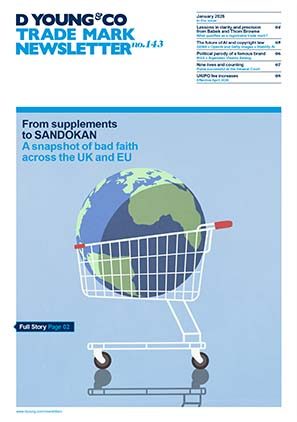Cadbury fails to safeguard UK purple TM registration
This a case in relation to which Cadbury tried, and unfortunately failed, to safeguard, to the extent possible, its UK trade mark registration for the colour purple.
Cadbury decided to take action to change the description of its 1995 UK trade mark registration no. 2020876a, for the colour purple, following the successful opposition by Nestlé against Cadbury’s later filed application (dating from 2004) to register the colour purple under trade mark no 2376879. The 2004 trade mark application was refused on the basis that it was not considered to be a sign that is “graphically represented”. The later application described the sign as “The colour purple (Pantone 2685C), as shown on the form of application, applied to the whole visible surface, or being the predominant colour applied to the whole visible surface, of the packaging of the goods”.
The earlier trade mark registration bears an almost identical description: “The mark consists of the colour purple (Pantone 2685C) as shown on the form of application, applied to the whole visible surface, or being the predominant colour applied to the whole visible surface, of the packaging of the goods”. In the case against the 2004 application, it had been decided that the wording referring to the colour purple “being the predominant colour applied to the whole visible surface, of the packaging of the goods” was lacking in clarity and precision as the description could cover numerous different combinations of colours. As the wording for the later mark is basically identical to the wording for the earlier mark, there is an argument that the earlier mark is indeed vulnerable to attack and, consequently, Cadbury applied to remove the part of the description of the mark referring to the “predominant colour”. Cadbury argued that the case against the later mark had established that the description effectively covered two marks that should be considered to be a series.
Cadbury’s application to remove the part of the description including reference to the “predominant colour” was refused by the registrar and the appeal to the High Court was unsuccessful. In this appeal from the High Court, reference was made to the practice concerning series marks and to the fact that only very limited alterations can be made to a registered trade mark.
With regard to a series of marks, the judge pointed out that, even though, at the application stage, it may not have been made clear that an application covers a series of marks, it does not mean that a series of marks cannot be registered. However, in this case, the description attached to the 1995 application referred to a mark in the singular and there was no supporting evidence to indicate that the registration covered a series of marks. The judge commented that the description, albeit lacking in clarity, basically appears to be trying to cover any mark featuring purple as the predominant colour whether that mark might be combined with different colours and take the form of different patterns or feature no other colour (ie, consist of purple alone). The registration communicates to the consumer “a generalised but imprecise description of a single mark”.
On the basis that the description of the mark effectively covers a infinite number of signs made up of the predominant colour purple potentially in combination with other colours and possibly taking the form of a number of different patterns, it could not constitute a series as the marks within a series must “resemble each other as to their material particulars and differ only as to matters of a non-distinctive character and not substantially affecting the identity of the trade mark”.
The judge could not allow the appeal and Cadbury therefore remains the owner of a registration for the colour purple described in an imprecise manner, consequently leaving the registration open to attack, particularly by Nestlé.
Colour marks are very difficult to register but others can learn from Cadbury’s efforts to safeguard its colour purple.

